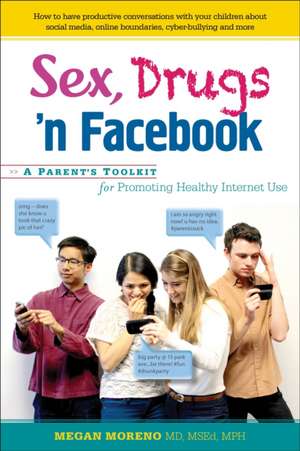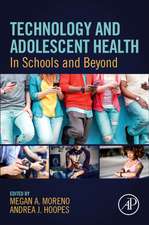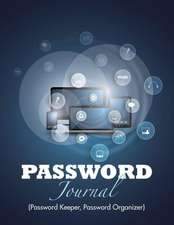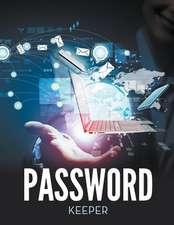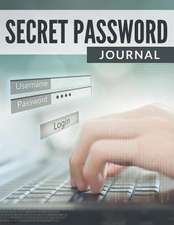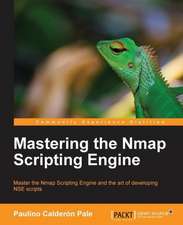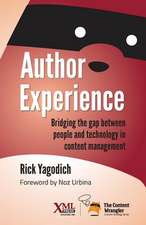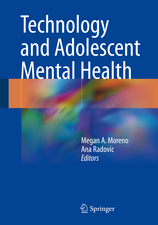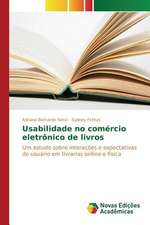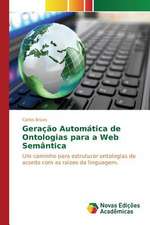Sex, Drugs 'n Facebook: A Parent's Toolkit for Promoting Healthy Internet Use
Autor Megan A. Morenoen Limba Engleză Paperback – 30 sep 2013
Vezi toate premiile Carte premiată
IndieFab awards (2013)
Forget sex, drugs, and rock & roll — today's parents and teachers have to deal with cyberbullying, sexting, internet addiction, and exposure to inappropriate online content. Fortunately, expert researcher Dr. Megan Moreno has written this book as a guide to help you teach your kids about balance and boundaries in their internet and media use and the skills they need to thrive online.
Sex, Drugs 'n Facebook will help you to zero in on the problem — and the solution. Backed by researchers funded by a $2.5 million NIH grant, this guide provides a clear toolkit for teaching our young people how to avoid the dangers of the internet while taking advantage of its full potential.
The book is grounded in the real experiences of young people on the internet. Incorporating the insight of teens and college-age students, each chapter includes real-life case studies and helpful new methods for productive conversations about these situations, in your own home or classroom.
Dr. Moreno gives actionable advice based on the most cutting-edge research in social media and technology use. Respectful of the needs of both children and adults, Sex, Drugs 'n Facebook is the smart guide to raising cybersensible kids.
Sex, Drugs 'n Facebook will help you to zero in on the problem — and the solution. Backed by researchers funded by a $2.5 million NIH grant, this guide provides a clear toolkit for teaching our young people how to avoid the dangers of the internet while taking advantage of its full potential.
The book is grounded in the real experiences of young people on the internet. Incorporating the insight of teens and college-age students, each chapter includes real-life case studies and helpful new methods for productive conversations about these situations, in your own home or classroom.
Dr. Moreno gives actionable advice based on the most cutting-edge research in social media and technology use. Respectful of the needs of both children and adults, Sex, Drugs 'n Facebook is the smart guide to raising cybersensible kids.
Preț: 84.09 lei
Preț vechi: 105.12 lei
-20% Nou
Puncte Express: 126
Preț estimativ în valută:
16.09€ • 16.80$ • 13.32£
16.09€ • 16.80$ • 13.32£
Carte disponibilă
Livrare economică 15-29 martie
Preluare comenzi: 021 569.72.76
Specificații
ISBN-13: 9780897936590
ISBN-10: 0897936590
Pagini: 214
Ilustrații: Color photos throughout
Dimensiuni: 150 x 226 x 18 mm
Greutate: 0.3 kg
Editura: Hunter House Publishers
ISBN-10: 0897936590
Pagini: 214
Ilustrații: Color photos throughout
Dimensiuni: 150 x 226 x 18 mm
Greutate: 0.3 kg
Editura: Hunter House Publishers
Cuprins
TABLE OF CONTENTS
Foreword
Introduction
Part I: Getting in the Know
Chapter 1: The Wide Web of the World Wide Web
Chapter 2: Understanding Internet Use Across Ages and Stages
Chapter 3: Don’t Worry, Be Happy - Using Balance, Boundaries and Communication to Stay Safe Online
Part II: Making a Difference
Chapter 4: You Saw What on YouTube? Handling Exposure to Unwanted Material Online
Chapter 5: Surfing Porn (and Other Dangerous Sites)
Chapter 6: Cyberbullying and the Invisible Black Eye
Chapter 7: Sex, Drugs, Rock 'n Roll—and FaceBook? Media Use and Risky Behaviors
Chapter 8: Addicted to the Internet?
Chapter 9: Safeguarding Online Identity and the Digital Footprint
Chapter 10: Do Online Sexual Predators Really Exist?
Conclusion: Working Together, We Can Make a Difference
Acknowledgments
Foreword
Introduction
Part I: Getting in the Know
Chapter 1: The Wide Web of the World Wide Web
Chapter 2: Understanding Internet Use Across Ages and Stages
Chapter 3: Don’t Worry, Be Happy - Using Balance, Boundaries and Communication to Stay Safe Online
Part II: Making a Difference
Chapter 4: You Saw What on YouTube? Handling Exposure to Unwanted Material Online
Chapter 5: Surfing Porn (and Other Dangerous Sites)
Chapter 6: Cyberbullying and the Invisible Black Eye
Chapter 7: Sex, Drugs, Rock 'n Roll—and FaceBook? Media Use and Risky Behaviors
Chapter 8: Addicted to the Internet?
Chapter 9: Safeguarding Online Identity and the Digital Footprint
Chapter 10: Do Online Sexual Predators Really Exist?
Conclusion: Working Together, We Can Make a Difference
Acknowledgments
Extras
Excerpt from Chapter 3: Don’t Worry, Be Happy — Using Balance, Boundaries, and Communication to Stay Safe Online
Almost all American parents knowsthat someday, as their kids get older, it will be time to talk with them about sex. It can be awkward, it might even be dreaded… but most parents will eventually tackle the "birds and the bees" conversation when their kids get old enough.
What happens, though, when it comes to conversations about safe Internet use? In reality, it’s just not as much of a tradition to have a safe-Internet talk in the family as it is to have talks about puberty and sex.
When it comes to the safe-Internet talk, some parents have an inkling that the conversation needs to take place. Others assume that it’s not necessary. These days it seems that kids have been learning about computers since birth, after all, and they sometimes seem to surpass even adults with their ease in navigating the online world. They should be naturals, right? Digital natives!
Unfortunately, when parents don’t get proactively involved in shaping a young person’s interactions with the online world, bad things can happen quickly.
Hannah was a 13-year-old girl making her way through middle school like many of her peers (all names and some details have been changed to protect the identity of individuals). She got B’s in most subjects, worked on the school newspaper, and kept busy at night texting with her friends. Then one day Hannah got into a texting match with a boy named Caleb. She had recently started flirting with him, after meeting him at a speech competition, and she really, really hoped he liked her back.
Then she had an idea. She could send him something to keep his interest going. Hannah took a photo of herself topless with her smart phone and texted it to Caleb. This situation quickly spiraled out of control. A few days later, a teacher confiscated Hannah’s cell phone because she was using it in class, against school policy. The teacher found the text with the nude photo of Hannah, and the administration felt compelled to call the police.
Since Hannah’s new boyfriend lived across the state border (just a few miles away), Hannah, Caleb, their families, and the school were now involved in a case of distribution of child pornography across state lines — a felony under federal law. Whoops!
Hannah’s mom never thought her daughter would do something like this; Hannah had always been sweet, respectful, and responsible. Unfortunately, adolescent hormones and her sincere interest in getting Caleb to like her clouded her judgment. After the family was called into the principal’s office, Mom felt a bit like a fool. In retrospect, she wished she had had the Internet talk with Hannah before this uncomfortable turn of events. Not after!
Communication — the safe-Internet talk and more — is an essential part of helping young people stay safe online. In this chapter, we cover communication, as well as balance and boundaries, as part of a three-pronged approach to keeping young people safe online. No parent wants to see his or her child sending or receiving nude photos over the cell phone — or engaging in any other variety of possibly foolish, dangerous, or illegal online or high-tech activities. Thankfully, by regularly using the balance – boundaries – communication model with young people, early on, most parents will never have to!
Developing a Practical Model for Keeping Young People Safe
A couple of years ago, the American Academy of Pediatrics came to our research team with a special request. The challenge?
To help them develop a pamphlet that could be used by doctors in the clinic setting to guide discussions with their teenage patients about Internet use. We took the challenge on and began working to create something that was helpful and up to date.
The American Academy of Pediatrics is the voice for children’s health in the US, so we knew we had a chance to work with some amazing people there, in the hopes of connecting many new young people and their families with valuable information on Internet safety.
Our goals when developing the model that would be used in this pamphlet were clear: We wanted the model to be one that parents and professionals could easily recall and reinforce in both scary situations and casual conversations about a child’s Internet use. We also wanted to create a pamphlet that would be adaptable to all ages of young people and to differing family values. Finally, we wanted the model to be supported by research on Internet use and safe Internet behaviors—not just anecdotes or second-guesses.
With these goals in mind, we developed a model and product that was valid, up-to-date, supported by current research, could stand the test of time, and easily triggered when an emergency conversation became necessary. After much reflection and many discussions with experts in the field of adolescent health, including experienced physicians and researchers, we chose three essential elements that parents and youth educators could easily incorporate into their Internet safety discussions and efforts: balance, boundaries, and communication.
We have since successfully applied this model in multiple settings — from workshops to classrooms to doctors’ offices—and have implemented it as the backbone of this book as well so that you as parents, adults, and professionals will have an easy toolset to use when you want to support the young people you care about in staying safe online.
Here’s a quick overview of the three elements that make up what we now call the Healthy Internet Use model.
Balance refers to the importance of creating an equilibrium between young people’s online and offline worlds
Boundaries refers to the importance of having clear guidelines about what is and isn’t an appropriate online interaction
Communication refers to the importance of creating a safe and effective environment for discussion between adults and young people about how the young person is using and experiencing the Internet.
In our view, these three elements cover the essentials for encouraging healthy Internet use: A young person who has the right balance, maintains a good set of online boundaries, and has regular communication with a trusted adult about his or her Internet experiences has all he or she needs to be a safe and happy Internet citizen. By using balance, boundaries, and communication as conversation topics from the moment a child connects to the Internet, parents and professionals can send an effective and consistent message to young people about how they can interact online in a way that is most beneficial to them. As these topics are reinforced as the child grows, young people will become equipped with the information and skills necessary to be successful Internet users at all stages and experiences of their lives, even when they don’t have an adult by their side to offer advice.
The Healthy Internet Use Model, Up Close
So, the Healthy Internet Use model focuses on three essential elements: balance, boundaries, and communication. These elements are grounded in the idea that the Internet has lots to offer young people and that, with a little support and guidance from a trusted adult, young people can make good judgments about how and when to use the Internet, as well as related technology, such as mobile and smart phones.
Balance
Balance, within this context, points to the question of whether a healthy equilibrium exists between a young person’s online and offline activities. Consider these examples, which point to various issues involving imbalance:
the college student who stays up till 4AM most weeknights playing the new game he just downloaded to his iPad and who then begins to miss morning classes in order to sleep in late
the high-schooler who feels unable to leave her cell phone in her school locker because she feels like she needs to check her texts during class time
the tween who accepts everything he sees online as reality rather than considering that it could be a representation of one viewpoint or even a false statement
Each of these scenarios points to the issue of imbalance. Let’s look a little closer now at healthy balance and begin to define what it really looks like.
We describe healthy balance as spending the right amount of time online for a given young person—enough time to constructively participate in today’s online world without tipping into the realm of concerns, such as too much time spent on the Internet, reliance on the Internet as a sole source of socialization, or feelings of withdrawal when away from the Internet. The American Academy of Pediatrics provides guidelines for children to avoid over two hours of media time per day; however, it has long been unclear how these recommendations translate to teens and young adults. In our model, we have purposely decided not to quantify healthy balance in exact time limits for this older age group. We think it’s more appropriate for adults and young people (tweens and up) to explore together what degree of balance works best for that particular young person and his or her situation.
For example, while one young person may be able to handle two hours of high-tech or media time across the day, another might do better with far less. It depends on the young person—his or her personality, "constitution," maturity, health status, and situation.
There are several ways to consider balance in your own family setting (or that of school, clinic, etc). Does the tween’s personality become altered after too much time playing video games? Can the college-aged student retain an upbeat attitude if she’s been in her dorm room for a long time instant messaging friends and playing around on Facebook? Do the parent and high schooler feel comfortable with an online marathon of video-watching over winter break but agree that this doesn’t work well on a normal school week? In our view, the answer depends on the situation, family goals and values, and the young person.
Even without an exact defined "threshold" for when balance tips over into imbalance, imbalance between online and offline worlds can most definitely occur. Adults often start to sense that imbalance when they see it or hear about it. Young people are often able to identify it too, at a gut level or when prompted to reflect. In such situations—or ideally before—parents can help young people consider that there are simply times that it’s important to turn the Internet off and be fully present in the "real world," like during dinner, during classes at school, or at bedtime.
Parents and adults may also take time to educate young people about what can happen if they do tip the online–offline balance, for example, by neglecting a homework assignment or falling asleep in class because they stayed up late playing an online video game. Failing grades or a bad high school transcript (leading to less college acceptances) are all real possibilities that parents can help the young person consider.
At its worst, imbalance can start to head in the direction of Internet addiction (or what we researchers call problematic use). Is it possible to have too much of a good thing like the Internet? While there have been some studies that have discussed the potential of compulsive Internet use or Internet addiction, the verdict is still out as to whether full-scale addiction—on par with alcohol or gambling addiction—actually exists. But researchers are investigating to learn more, and many psychologists and doctors say they are getting increasing numbers of requests by parents and patients to be evaluated for suspected problematic Internet use. (See Chapter 8 for more information on problematic Internet use.)
Almost all American parents knowsthat someday, as their kids get older, it will be time to talk with them about sex. It can be awkward, it might even be dreaded… but most parents will eventually tackle the "birds and the bees" conversation when their kids get old enough.
What happens, though, when it comes to conversations about safe Internet use? In reality, it’s just not as much of a tradition to have a safe-Internet talk in the family as it is to have talks about puberty and sex.
When it comes to the safe-Internet talk, some parents have an inkling that the conversation needs to take place. Others assume that it’s not necessary. These days it seems that kids have been learning about computers since birth, after all, and they sometimes seem to surpass even adults with their ease in navigating the online world. They should be naturals, right? Digital natives!
Unfortunately, when parents don’t get proactively involved in shaping a young person’s interactions with the online world, bad things can happen quickly.
Hannah was a 13-year-old girl making her way through middle school like many of her peers (all names and some details have been changed to protect the identity of individuals). She got B’s in most subjects, worked on the school newspaper, and kept busy at night texting with her friends. Then one day Hannah got into a texting match with a boy named Caleb. She had recently started flirting with him, after meeting him at a speech competition, and she really, really hoped he liked her back.
Then she had an idea. She could send him something to keep his interest going. Hannah took a photo of herself topless with her smart phone and texted it to Caleb. This situation quickly spiraled out of control. A few days later, a teacher confiscated Hannah’s cell phone because she was using it in class, against school policy. The teacher found the text with the nude photo of Hannah, and the administration felt compelled to call the police.
Since Hannah’s new boyfriend lived across the state border (just a few miles away), Hannah, Caleb, their families, and the school were now involved in a case of distribution of child pornography across state lines — a felony under federal law. Whoops!
Hannah’s mom never thought her daughter would do something like this; Hannah had always been sweet, respectful, and responsible. Unfortunately, adolescent hormones and her sincere interest in getting Caleb to like her clouded her judgment. After the family was called into the principal’s office, Mom felt a bit like a fool. In retrospect, she wished she had had the Internet talk with Hannah before this uncomfortable turn of events. Not after!
Communication — the safe-Internet talk and more — is an essential part of helping young people stay safe online. In this chapter, we cover communication, as well as balance and boundaries, as part of a three-pronged approach to keeping young people safe online. No parent wants to see his or her child sending or receiving nude photos over the cell phone — or engaging in any other variety of possibly foolish, dangerous, or illegal online or high-tech activities. Thankfully, by regularly using the balance – boundaries – communication model with young people, early on, most parents will never have to!
Developing a Practical Model for Keeping Young People Safe
A couple of years ago, the American Academy of Pediatrics came to our research team with a special request. The challenge?
To help them develop a pamphlet that could be used by doctors in the clinic setting to guide discussions with their teenage patients about Internet use. We took the challenge on and began working to create something that was helpful and up to date.
The American Academy of Pediatrics is the voice for children’s health in the US, so we knew we had a chance to work with some amazing people there, in the hopes of connecting many new young people and their families with valuable information on Internet safety.
Our goals when developing the model that would be used in this pamphlet were clear: We wanted the model to be one that parents and professionals could easily recall and reinforce in both scary situations and casual conversations about a child’s Internet use. We also wanted to create a pamphlet that would be adaptable to all ages of young people and to differing family values. Finally, we wanted the model to be supported by research on Internet use and safe Internet behaviors—not just anecdotes or second-guesses.
With these goals in mind, we developed a model and product that was valid, up-to-date, supported by current research, could stand the test of time, and easily triggered when an emergency conversation became necessary. After much reflection and many discussions with experts in the field of adolescent health, including experienced physicians and researchers, we chose three essential elements that parents and youth educators could easily incorporate into their Internet safety discussions and efforts: balance, boundaries, and communication.
We have since successfully applied this model in multiple settings — from workshops to classrooms to doctors’ offices—and have implemented it as the backbone of this book as well so that you as parents, adults, and professionals will have an easy toolset to use when you want to support the young people you care about in staying safe online.
Here’s a quick overview of the three elements that make up what we now call the Healthy Internet Use model.
Balance refers to the importance of creating an equilibrium between young people’s online and offline worlds
Boundaries refers to the importance of having clear guidelines about what is and isn’t an appropriate online interaction
Communication refers to the importance of creating a safe and effective environment for discussion between adults and young people about how the young person is using and experiencing the Internet.
In our view, these three elements cover the essentials for encouraging healthy Internet use: A young person who has the right balance, maintains a good set of online boundaries, and has regular communication with a trusted adult about his or her Internet experiences has all he or she needs to be a safe and happy Internet citizen. By using balance, boundaries, and communication as conversation topics from the moment a child connects to the Internet, parents and professionals can send an effective and consistent message to young people about how they can interact online in a way that is most beneficial to them. As these topics are reinforced as the child grows, young people will become equipped with the information and skills necessary to be successful Internet users at all stages and experiences of their lives, even when they don’t have an adult by their side to offer advice.
The Healthy Internet Use Model, Up Close
So, the Healthy Internet Use model focuses on three essential elements: balance, boundaries, and communication. These elements are grounded in the idea that the Internet has lots to offer young people and that, with a little support and guidance from a trusted adult, young people can make good judgments about how and when to use the Internet, as well as related technology, such as mobile and smart phones.
Balance
Balance, within this context, points to the question of whether a healthy equilibrium exists between a young person’s online and offline activities. Consider these examples, which point to various issues involving imbalance:
the college student who stays up till 4AM most weeknights playing the new game he just downloaded to his iPad and who then begins to miss morning classes in order to sleep in late
the high-schooler who feels unable to leave her cell phone in her school locker because she feels like she needs to check her texts during class time
the tween who accepts everything he sees online as reality rather than considering that it could be a representation of one viewpoint or even a false statement
Each of these scenarios points to the issue of imbalance. Let’s look a little closer now at healthy balance and begin to define what it really looks like.
We describe healthy balance as spending the right amount of time online for a given young person—enough time to constructively participate in today’s online world without tipping into the realm of concerns, such as too much time spent on the Internet, reliance on the Internet as a sole source of socialization, or feelings of withdrawal when away from the Internet. The American Academy of Pediatrics provides guidelines for children to avoid over two hours of media time per day; however, it has long been unclear how these recommendations translate to teens and young adults. In our model, we have purposely decided not to quantify healthy balance in exact time limits for this older age group. We think it’s more appropriate for adults and young people (tweens and up) to explore together what degree of balance works best for that particular young person and his or her situation.
For example, while one young person may be able to handle two hours of high-tech or media time across the day, another might do better with far less. It depends on the young person—his or her personality, "constitution," maturity, health status, and situation.
There are several ways to consider balance in your own family setting (or that of school, clinic, etc). Does the tween’s personality become altered after too much time playing video games? Can the college-aged student retain an upbeat attitude if she’s been in her dorm room for a long time instant messaging friends and playing around on Facebook? Do the parent and high schooler feel comfortable with an online marathon of video-watching over winter break but agree that this doesn’t work well on a normal school week? In our view, the answer depends on the situation, family goals and values, and the young person.
Even without an exact defined "threshold" for when balance tips over into imbalance, imbalance between online and offline worlds can most definitely occur. Adults often start to sense that imbalance when they see it or hear about it. Young people are often able to identify it too, at a gut level or when prompted to reflect. In such situations—or ideally before—parents can help young people consider that there are simply times that it’s important to turn the Internet off and be fully present in the "real world," like during dinner, during classes at school, or at bedtime.
Parents and adults may also take time to educate young people about what can happen if they do tip the online–offline balance, for example, by neglecting a homework assignment or falling asleep in class because they stayed up late playing an online video game. Failing grades or a bad high school transcript (leading to less college acceptances) are all real possibilities that parents can help the young person consider.
At its worst, imbalance can start to head in the direction of Internet addiction (or what we researchers call problematic use). Is it possible to have too much of a good thing like the Internet? While there have been some studies that have discussed the potential of compulsive Internet use or Internet addiction, the verdict is still out as to whether full-scale addiction—on par with alcohol or gambling addiction—actually exists. But researchers are investigating to learn more, and many psychologists and doctors say they are getting increasing numbers of requests by parents and patients to be evaluated for suspected problematic Internet use. (See Chapter 8 for more information on problematic Internet use.)
Notă biografică
Premii
- IndieFab awards Honorable Mention, 2013
